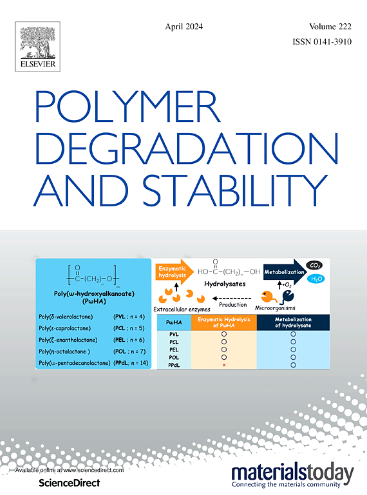Pressure-induced formability and degradability of block copolymers composed of poly(1,5-dioxepan-2-one) and poly(L-lactide)
IF 6.3
2区 化学
Q1 POLYMER SCIENCE
引用次数: 0
Abstract
An aliphatic polyether/carbonate block copolymer, comprising poly(1,5-dioxepan-2-one) (PDXO, glass transition temperature Tg: -38 °C) and poly(L-lactide) (PLLA, Tg: 55 °C), evinces remarkable formability under pressure at temperatures significantly below the melting point of PLLA. A quantitative and detailed evaluation of the low-temperature molding of the block copolymer was conducted using a capillary rheometer. The findings reveal that block copolymers with PDXO composition >55 wt% demonstrate a propensity to flow at room temperature under 50 MPa pressure. Consequently, the practice of low-temperature molding serves to mitigate the degradation of polymer chains during the molding process, thereby augmenting recyclability. Furthermore, the enzymatic degradability of the block copolymer was extensively investigated using lipase PS and proteinase K. An interplay between the structure of the block copolymer and the degradation kinetics was explored. The polymeric materials developed, possessing both pressure formability and degradability, hold promising potential as environmentally benign polymers with reduced environmental impact.
聚(1,5-二氧杂环庚烷-2-酮)和聚(L-内酰胺)嵌段共聚物的压力诱导成型性和降解性
一种脂肪族聚醚/碳酸酯嵌段共聚物由聚(1,5-二氧杂环庚烷-2-酮)(PDXO,玻璃化温度 Tg:-38 °C)和聚(L-乳酸)(PLLA,玻璃化温度 Tg:55 °C)组成,在压力下的成型性非常显著,温度明显低于 PLLA 的熔点。使用毛细管流变仪对嵌段共聚物的低温成型进行了详细的定量评估。研究结果表明,PDXO 含量为 55 wt%的嵌段共聚物在室温、50 兆帕压力下具有流动倾向。因此,低温模塑可减轻聚合物链在模塑过程中的降解,从而提高可回收性。此外,还使用脂肪酶 PS 和蛋白酶 K 对嵌段共聚物的酶降解性进行了广泛研究。所开发的聚合物材料具有压力成型性和降解性,有望成为对环境影响较小的无害聚合物。
本文章由计算机程序翻译,如有差异,请以英文原文为准。
求助全文
约1分钟内获得全文
求助全文
来源期刊

Polymer Degradation and Stability
化学-高分子科学
CiteScore
10.10
自引率
10.20%
发文量
325
审稿时长
23 days
期刊介绍:
Polymer Degradation and Stability deals with the degradation reactions and their control which are a major preoccupation of practitioners of the many and diverse aspects of modern polymer technology.
Deteriorative reactions occur during processing, when polymers are subjected to heat, oxygen and mechanical stress, and during the useful life of the materials when oxygen and sunlight are the most important degradative agencies. In more specialised applications, degradation may be induced by high energy radiation, ozone, atmospheric pollutants, mechanical stress, biological action, hydrolysis and many other influences. The mechanisms of these reactions and stabilisation processes must be understood if the technology and application of polymers are to continue to advance. The reporting of investigations of this kind is therefore a major function of this journal.
However there are also new developments in polymer technology in which degradation processes find positive applications. For example, photodegradable plastics are now available, the recycling of polymeric products will become increasingly important, degradation and combustion studies are involved in the definition of the fire hazards which are associated with polymeric materials and the microelectronics industry is vitally dependent upon polymer degradation in the manufacture of its circuitry. Polymer properties may also be improved by processes like curing and grafting, the chemistry of which can be closely related to that which causes physical deterioration in other circumstances.
 求助内容:
求助内容: 应助结果提醒方式:
应助结果提醒方式:


